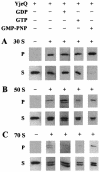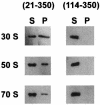Studies of the interaction of Escherichia coli YjeQ with the ribosome in vitro
- PMID: 14973029
- PMCID: PMC344419
- DOI: 10.1128/JB.186.5.1381-1387.2004
Studies of the interaction of Escherichia coli YjeQ with the ribosome in vitro
Abstract
Escherichia coli YjeQ represents a conserved group of bacteria-specific nucleotide-binding proteins of unknown physiological function that have been shown to be essential to the growth of E. coli and Bacillus subtilis. The protein has previously been characterized as possessing a slow steady-state GTP hydrolysis activity (8 h(-1)) (D. M. Daigle, L. Rossi, A. M. Berghuis, L. Aravind, E. V. Koonin, and E. D. Brown, Biochemistry 41: 11109-11117, 2002). In the work reported here, YjeQ from E. coli was found to copurify with ribosomes from cell extracts. The copy number of the protein per cell was nevertheless low relative to the number of ribosomes (ratio of YjeQ copies to ribosomes, 1:200). In vitro, recombinant YjeQ protein interacted strongly with the 30S ribosomal subunit, and the stringency of that interaction, revealed with salt washes, was highest in the presence of the nonhydrolyzable GTP analog 5'-guanylylimidodiphosphate (GMP-PNP). Likewise, association with the 30S subunit resulted in a 160-fold stimulation of YjeQ GTPase activity, which reached a maximum with stoichiometric amounts of ribosomes. N-terminal truncation variants of YjeQ revealed that the predicted OB-fold region was essential for ribosome binding and GTPase stimulation, and they showed that an N-terminal peptide (amino acids 1 to 20 in YjeQ) was necessary for the GMP-PNP-dependent interaction of YjeQ with the 30S subunit. Taken together, these data indicate that the YjeQ protein participates in a guanine nucleotide-dependent interaction with the ribosome and implicate this conserved, essential GTPase as a novel factor in ribosome function.
Figures







Similar articles
-
Genetic interaction screens with ordered overexpression and deletion clone sets implicate the Escherichia coli GTPase YjeQ in late ribosome biogenesis.J Bacteriol. 2008 Apr;190(7):2537-45. doi: 10.1128/JB.01744-07. Epub 2008 Jan 25. J Bacteriol. 2008. PMID: 18223068 Free PMC article.
-
The C-terminal helix in the YjeQ zinc-finger domain catalyzes the release of RbfA during 30S ribosome subunit assembly.RNA. 2015 Jun;21(6):1203-16. doi: 10.1261/rna.049171.114. Epub 2015 Apr 22. RNA. 2015. PMID: 25904134 Free PMC article.
-
YjeQ, an essential, conserved, uncharacterized protein from Escherichia coli, is an unusual GTPase with circularly permuted G-motifs and marked burst kinetics.Biochemistry. 2002 Sep 17;41(37):11109-17. doi: 10.1021/bi020355q. Biochemistry. 2002. PMID: 12220175
-
Non-ribosomal factors in ribosome subunit assembly are emerging targets for new antibacterial drugs.Curr Opin Pharmacol. 2006 Oct;6(5):453-8. doi: 10.1016/j.coph.2006.05.005. Epub 2006 Aug 4. Curr Opin Pharmacol. 2006. PMID: 16890019 Review.
-
[Ribosome: lessons of a molecular factory construction].Mol Biol (Mosk). 2014 Jul-Aug;48(4):543-60. Mol Biol (Mosk). 2014. PMID: 25842841 Review. Russian.
Cited by
-
The GTPase, CpgA(YloQ), a putative translation factor, is implicated in morphogenesis in Bacillus subtilis.Mol Genet Genomics. 2006 Apr;275(4):409-20. doi: 10.1007/s00438-006-0097-9. Epub 2006 Feb 17. Mol Genet Genomics. 2006. PMID: 16485133
-
Arabidopsis BPG2: a phytochrome-regulated gene whose protein product binds to plastid ribosomal RNAs.Planta. 2012 Aug;236(2):677-90. doi: 10.1007/s00425-012-1638-6. Epub 2012 Apr 10. Planta. 2012. PMID: 22526496
-
Structural stabilization of GTP-binding domains in circularly permuted GTPases: implications for RNA binding.Nucleic Acids Res. 2006 Apr 28;34(8):2196-205. doi: 10.1093/nar/gkl178. Print 2006. Nucleic Acids Res. 2006. PMID: 16648363 Free PMC article.
-
Genetic interaction screens with ordered overexpression and deletion clone sets implicate the Escherichia coli GTPase YjeQ in late ribosome biogenesis.J Bacteriol. 2008 Apr;190(7):2537-45. doi: 10.1128/JB.01744-07. Epub 2008 Jan 25. J Bacteriol. 2008. PMID: 18223068 Free PMC article.
-
E. coli HflX interacts with 50S ribosomal subunits in presence of nucleotides.Biochem Biophys Res Commun. 2009 Feb 6;379(2):201-5. doi: 10.1016/j.bbrc.2008.12.072. Epub 2008 Dec 25. Biochem Biophys Res Commun. 2009. PMID: 19109926 Free PMC article.
References
-
- An, G., B. R. Glick, J. D. Friesen, and M. C. Ganoza. 1980. Identification and quantitation of elongation factor EF-P in Escherichia coli cell-free extracts. Can. J. Biochem. 97:23-28. - PubMed
-
- Aoki, H., K. Dekany, S.-L. Adams, and M. C. Ganoza. 1997. The gene encoding the elongation factor P protein is essential for viability and is required for protein synthesis. J. Biol. Chem. 272:32254-32259. - PubMed
-
- Arcus, V. 2002. OB-fold domains: a snapshot of the evolution of sequence, structure and function. Curr. Opin. Struct. Biol. 12:794-801. - PubMed
-
- Arigoni, F., F. Talabot, M. Peitsch, M. D. Edgerton, E. Meldrum, E. Allet, R. Fish, T. Jamotte, M. L. Curchod, and H. Loferer. 1998. A genome-based approach for the identification of essential bacterial genes. Nat. Biotechnol. 16:851-856. - PubMed
-
- Ausubel, F. M., R. Brent, R. E. Kingston, D. D. Moore, J. G. Seidman, J. A. Smith, and K. Struhl. 1994. Current protocols in molecular biology, vol. 2, chapter 11, section 11.12-11.13. John Wiley & Sons Inc., Boston, Mass.
MeSH terms
Substances
LinkOut - more resources
Full Text Sources
Molecular Biology Databases
Miscellaneous

